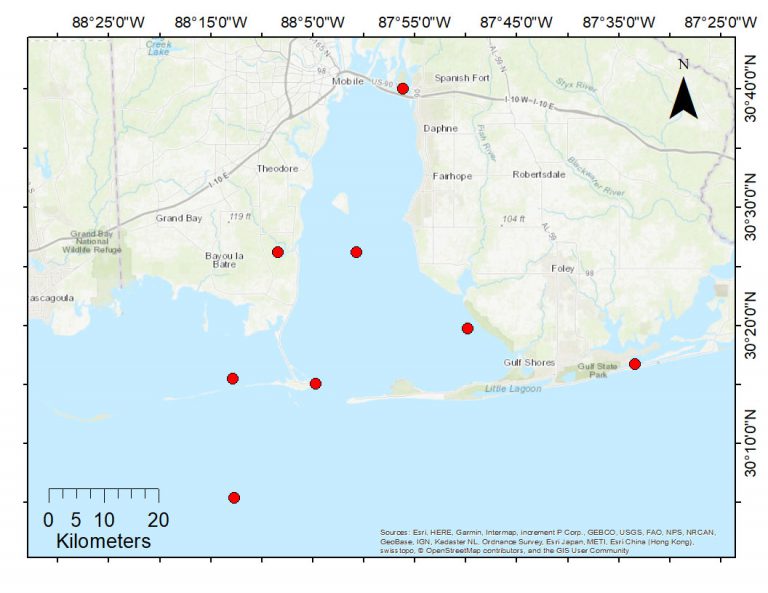Full Title: Expansion of www.mymobilebay.com [now known as ARCOS] for coastal Alabama resource management
This project improved and expanded an observing network and website that provides accurate real-time weather and water quality data to Alabama environmental managers and the public.

The Team: Brian Dzwonkowski (Lead Investigator, University of South Alabama, Dauphin Island Sea Lab) and Renee Collini (Mississippi State University)
Technical Monitor: Grace Gray (grace.gray@noaa.gov)
Federal Program Officer/Point of Contact: Frank Parker (frank.parker@noaa.gov)
This project began in June 2017 and will end in May 2021.
Award Amount: $720,000
Why it matters: Effective management of coastal estuaries requires real-time and historical knowledge of water quality such as salinity, temperature, dissolved oxygen, and water clarity. Resource managers and stakeholders can use web-based tools that integrate this water quality data to inform decision-making in coastal waters such as when to close oyster harvesting areas due to poor water quality. Unfortunately, many Gulf of Mexico coastal regions lack web-based tools that effectively integrate available real-time and historical water quality data. However, decision-makers in Alabama have access to the Alabama Real-time Coastal Observing System (ARCOS) which provides high-quality, system wide, continuous real-time water and weather observations in a user-friendly web-based portal (https://arcos.disl.org/).
What the team is doing: The work conducted extended the spatial and temporal coverage for ARCOS and added more measures of water quality. This enhanced the usefulness of ARCOS for resource managers by providing them with additional information critical to making decisions about living coastal and marine resources in coastal Alabama. Specifically, the improvements to the ARCOS network included upgrading four older observing stations to enhance reliability and provide real-time water clarity data, and adding offshore real-time measurements of salinity, temperature, and dissolved oxygen by upgrading an existing data collection site.
Expected Outcome: This project led to improvements to ARCOS and its web portal, https://arcos.disl.org/, which receives over 7000 visitors per month who use its data to inform coastal decision-making including living resource management and recreational activities. This project expanded www.mymobilebay.com (now known as ARCOS) to include water clarity and offshore water quality data, improving the quality and quantity of information available to support coastal management, fisheries, and recreational use in Mobile Bay. This work also supported the use of ARCOS by recreational and commercial users who rely on the data it provides for safe and efficient boating, fishing, and shipping.
From the seminar “Expanding Alabama’s Real-time Coastal Observing System for coastal management applications”
Presenter: Dr. Brian Dzwonkowski, University of South Alabama
Other Resources
Dauphin Island Sea Lab. 2018. Alabama Near Coastal Meteorological & Hydrographic Continuous Data Sampling from 2003 to present. NOAA National Centers for Environmental Information. Dataset.
Dzwonkowski, B., and G. Lockridge. 2021. Fisheries Oceanography in Coastal Alabama (FOCAL) acoustic doppler wave and current profiler data from 2020-08-05 to 2021-06-03 (NCEI Accession 0241013). NOAA National Centers for Environmental Information. Dataset.
Dzwonkowski, B., and G. Lockridge. 2020. Fisheries Oceanography in Coastal Alabama (FOCAL) acoustic doppler wave and current profiler data 2018-06-21 to 2019-05-15 (NCEI Accession 0211052). NOAA National Centers for Environmental Information. Dataset.
Coogan, J., B. Dzwonkowski, K. Park, and G. Lockridge. 2019. West End CP Mooring thermistor, CTD, and ADCP Data near Mobile Bay, Alabama from 2004-10-20 to 2018-12-12 (NCEI Accession 0203749). NOAA National Centers for Environmental Information. Dataset.
Dzwonkowski, B., and G. Lockridge. 2019. CTD data collected from a Fisheries Oceanography in Coastal Alabama (FOCAL) transect on 2019-06-04 (NCEI Accession 0201339). NOAA National Centers for Environmental Information. Dataset.
Coming soon
Coming Soon
 Official websites use.gov
A .gov website belongs to an official government organization in the United States.
Official websites use.gov
A .gov website belongs to an official government organization in the United States.
 Secure .gov websites use HTTPS
A lock or https:// means you’ve safely connected to the .gov website. Share sensitive information only on official, secure websites.
Secure .gov websites use HTTPS
A lock or https:// means you’ve safely connected to the .gov website. Share sensitive information only on official, secure websites.